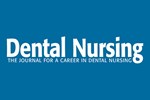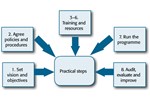
Exhaustion crossover between dentist and dental nurse
Hakanen JJ, Perhoniemi R, Bakker AB (2013) Crossover of exhaustion between dentists and dental nurses. Stress and Health. doi: 10.1002/smi.2498

Hakanen JJ, Perhoniemi R, Bakker AB (2013) Crossover of exhaustion between dentists and dental nurses. Stress and Health. doi: 10.1002/smi.2498

Judith Husband issues a rallying call for the BDA's new ‘Make a Meal of It’ campaign, which seeks to tackle the harm caused to children's dental health by between-meals snacking on sugary and acidic food and drink

Harris CM, Welbury R, Cairns AM (2013) The Scottish dental practitioner's role in managing child abuse and neglect. Br Dent J214: E24

Oral health is an important but often overlooked aspect of an older adult's general health. Daily oral hygiene, ability to access routine professional oral health services, and oral health education are all key factors that can improve the oral health of older people

The EU Sharps Directive came about in response to the fact that needlestick injuries are one of the most serious health and safety threats for healthcare workers. So how does it affect dental nurses?

The nature of Parkinson's disease, and some of the medication used to treat the condition, may mean that some patients will experience some oral health problems. The article explores the problems, looks at why they happen, and what can be done to help

This series of articles is designed to help you develop your continuing education as a dental nurse. The series examine different types of study days and courses that may be available to you and how to survive and complete the course. This article will help you make sense of course structures

Effective care coordination requires that each patient's needs and preferences for care are matched with the appropriate level of service and clinical expertise and that care decisions are based on knowledge of the patient and availability of care

Good oral health is part of good general health. Dental professionals can draw on evidence and epidemiological data and work with other professionals involved with children to plan and provide care and establish good oral care habits

Neglect is the commonest and one of the most harmful forms of child abuse. Dental professionals need to be aware of general and dental neglect, how to identify these problems and the action they need to take

This article is the seventh in a series of case studies illustrating the roles and responsibilities of the registered dental nurse. It will describe the guidance that is available, and the steps necessary, to avoid the legal and ethical problems that will be discussed

Dental nurses are often required to carry out initial assessment and triage of patients who attend the dental clinic on an emergency basis. This article, the second in a series of two articles, covers the immediate management of traumatic dental injury to permanent and primary dentition in children

With little specific advice available for infant and toddler oral care in the UK and dental professionals unsure as what to recommend, research-based practices in countries where the oral care of under-fives has a higher profile can help inform UK health professionals

Dental care professionals often experience work-related musculoskeletal disorders, usually linked to awkward posture and repetitive movements over a long period of time. Practitioners need to be aware of the risks and the steps they can take to minimise the likelihood of these injuries

Dental nurses are often required to carry out initial assessment and triage of patients who attend the dental clinic on an emergency basis. This article, the first in a series of two articles, covers the causes and classifications of dental trauma as well as the principles of history taking